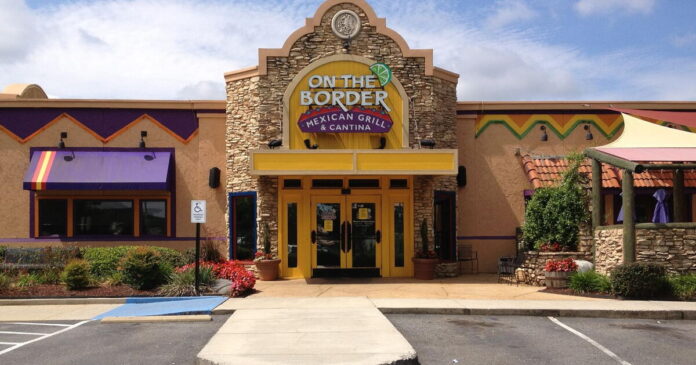Another famous dining chain has officially filed for Chapter 11 Protection and is closing 77 locations across the country. The past year has not been very profitable for many food chains in the country. Multiple dining chains have already filed for Chapter 11 protection against liquidation. Some of the famous dining chains that suffered the same fate are Red Lobster, TGI Fridays, and Roti. On The Border, the Mexican chain joined the long list of bankrupt food chains this year. If you want to know more about the Mexican chain closing 77 locations over bankruptcy, this article is for you.
Mexican Chain Closes 77 Locations Over Bankruptcy
What Reason Did The Chain Give In Their Official Statement?
On the 5th of March, On The Border’s owner OTB Holding LLC made an official announcement about its voluntary filing for Chapter 11 bankruptcy. The dining chain did not really state any reason for its bankruptcy in its official statement. However, many food chains have reported a significant decrease in foot traffic due to a rise in inflation. Chris Rockwood, who is the President of On The Border, said in a statement that reconstructing is the best way forward for them. It will give them enough time to face the financial challenges, reconstruct their strategies, and focus on their growth.
What Did The Chain State In Its Official Court Filing?
The Mexican chain completed its official court filing with the US Bankruptcy Court located in the Northern District of Georgia. Jonathan M., who is the chief reconstructing officer of OTB, mentioned a rapid loss of liquidity in the official filing. The loss resulted in the institute holding vendor payments and rent payments to maintain the levels of cash. As a result, the vendors as well as the landlords cut their services off, withheld goods, repossessed leased premises, and also exercised set-off rights. The company, therefore, lost stores and faced additional operational challenges, along with a severe liquidity crisis.
How Many Restaurants Does The Mexican Chain Have?
According to the official information obtained from the company, On The Border currently has over 150 restaurants. These restaurants are located across the United States of America as well as South Korea. According to the official court filing in Georgia, it is reported that the majority of these locations are located in the United States. On The Border reportedly operates around 110 locations in the United States across 26 states.
Mexican Chain Locations Closing Across USA
According to the official court filings, the food chain has already closed around 77 of its locations that were underperforming. The food chain has also asked the court to allow it to reject the leases on the closed locations. Major states like Arizona, Arkansas, Colorado, Connecticut, Florida, Georgia, and Illinois will witness location closures. Other states in America like Indiana, Iowa, Kansas, Maine, Maryland, Massachusetts, Michigan, Mississippi, Missouri, New Jersey, and New York will also have closures. North Carolina, Ohio, Oklahoma, Pennsylvania, Texas, and Virginia will also have locations closed.
What’s Next For The Employees Of The Mexican Chain?
The Mexican food chain closing 77 locations over bankruptcy is the source of employment for over 2800 workers. Out of these, around 375 are working full-time while 216 of them are full-time salaried employees. On the other hand, the 2210 workers that remain are part-time hourly employees. The court documents filed in Georgia state that the food chain has filed for first-day relief pleadings. This means it has sought permission from the court to keep paying its workers their wages.
The filing of Chapter 11 bankruptcy by the restaurant chain is an integral step for the popular Mexican-inspired restaurant chain. It allows the company to reorganize and attempt to recover from its financial difficulties. Also, it shows the hardship for many employees, vendors, and local communities. They all rely on its presence. Thus, the process provides an opportunity for the company to start afresh. They can restructure debts, renegotiate leases, and develop a new strategy to gain stability. They can also work on improving their restaurant’s profitability through this process.
Industry analysts suggest that the restaurant has been struggling due to several factors. Some of them include inflation, rising food costs, labor shortages, and changing consumer preferences. Also, many customers are now cautious about spending. They opt for fast-casual or lower-cost options. This is when compared to dine-in experiences present at traditional restaurants. Thus, this change has accelerated the decline of restaurants and chains. On The Border is one such example. They previously relied on a steady source of dine-in customers.
Their decline can also be traced to declining sales in certain regions. Also, increasing competition from other outlets such as Taco Bell, Chili’s adds to the factors. After COVID-19, the trend towards takeout and delivery has improved. However, On The Border has struggled to adapt swiftly to capture the changing market trends. These challenges collectively worsened its liquidity crisis. Thus, the restaurant was led to Chapter 11 bankruptcy.
Conclusion
Despite the challenges, On The Border remains positive for future changes. The company’s management has shown that restructuring could help focus on profitable locations. They could also improve their operational efficiency. Thus, they plan to renegotiate leases. Also, they plan to close underperforming stores. Then, they could potentially reopen some of the closed locations once they achieve financial stability. The hope is in this strategic shift. It is combined with cost-cutting measures and renewed marketing ideas. This will allow the restaurant chain to restructure and regain market share.
This case is an example of a broader trend of restaurant chains facing financial distress. This happens in a volatile economic environment with a lot of external factors. Thus, industry experts predict that several other chains may also face the same issue later. smaller and mid-sized chains may be affected in a similar manner as they lack financial incentives. However, their recovery and success depend on their ability to adjust to changing market trends and customer interests.








